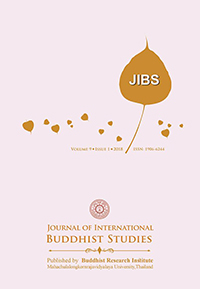Ways of Buddhadhamma Propagation: The Buddha’s Period to Today
Keywords:
Buddhadhamma Propagation, Buddha’s Period to TodayAbstract
This article is to discuss the development of ways in Buddhadhamma propagation from the Buddha’s period to the present time. Its main data source is gathered from Tipṭtaka, and Mahayāna texts, beside that the research is also added more collecting data from secondary sources such as books, writings, lectures, journals, theses, and online. Based on the concerned resources found, we will conduct an analysis in the results among studies and systematizing them in order to understand the development of the ways in propagation in the past and trends in the future. The final step of article will draw conclusions and the results for further research. Thus, the timeframe of this research can be divided into two periods: 1) during the Buddha’s period, 2) after the Buddha’s period to present time. The findings of this research show the results of the study can be inferred that development of ways in the propagation from the Buddha’s period to present time that have the active roles as essential factors in each period.
References
Armstrong, Billy. Educational Development and Technology. United Kingdom: ED-Tech Press, 2018.
Bapat. 2500 Year of Buddhism. New Delhi: Publications Division Delhi-8, 1956.
Barabudur, Puoting. The Legend of King Asoka. Hanoi: Imprimeried Extreme Orient, 1935.
Birgit, Meyer. Religious Sensations: Why Media, Aesthetics, and Power Matter in the Study of Contemporary Religion. Amsterdam: Vrje University, 2006.
Buddhadatta. Sammohavinodanī (Vibhaṅga-aṭṭhakathaā). Oxford: PTS, 1980.
Elizabeth, Morrison. The power of Patriarchs: Qisong and Lineage in Chinese Buddhism. Boston: Leiden, 2010.
Grieve, Gregory P. and Daniel Veidlinger. Buddhism the Internet and Digital Media: The Pixel in the Lotus. New York: Routledge, 1007.
Grieve, Gregory. Digital Religion: Understanding Religious Practice in New Media Worlds. New York: Routledge, 2012.
Hansen, Valerie. The Silk Road. New York: Oxford University press, 2012.
Hubbard, Benjamin J., James A. Santucci, and John T. Hatfield. An Educator's Classroom Guide to America's Religious Beliefs and Practices. Westport, Conn: Libraries Unlimited, 2007.
Janakabhivamsa. Abhidhamma in Daily Life. Yangon: International Theravada Buddhist Missionary University, 1999.
John, S. Strong. The Legend and Cult of Upagupta: Sanskit Buddhism in North India and Southeast Asia. United Kingdom: Princeton University Press, 2017.
Karkkainen, Veki-Matti. Trinity and Revelation. Cambridge: William B, Publishing Company, 2014.
Khoon, Chan. Buddhism Course. Malaysia: Leboh Bagor, 2012.
Krishan. The Buddha Image Its Origin and Development. New Delhi: Munshiram Monoharlal, 1996.
Narasabho, Singhathon. Buddhism: A Guide to a Happy Life. Germany: Buddhist University, 1971.
Phangcham, Buddhism for Young Students. The University of Virginia: Pim-Pun Printing Limited, 1993.
Piyadassi, The Buddha His Life and Teaching. Sri Lanka: Buddhist Publication Society, 1982.
Richard, Salomon. "On the Origin of the Early Indian Scripts: A Review Article." Journal of the American Oriental Society 115 (1995): 271-279.
Robert, Arp and Arthur Caplan. 1001 Ideas: That Changed The Way We Think. New York: Atria Books, 2013.
Snelling, John. The Buddhist Handbook: A Complete Guide to Buddhist Teaching and Practice. London: Random House, 2011.







